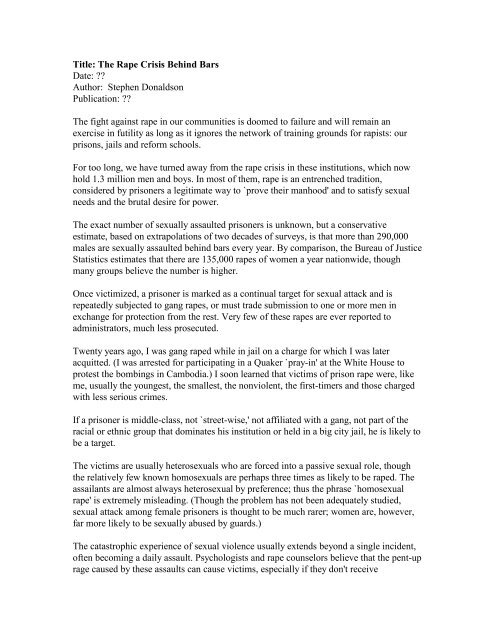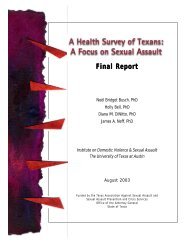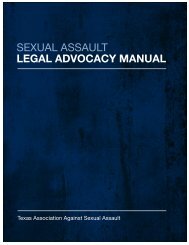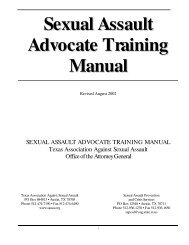THE RAPE CRISIS BEHIND BARS By Stephen Donaldson - Texas ...
THE RAPE CRISIS BEHIND BARS By Stephen Donaldson - Texas ...
THE RAPE CRISIS BEHIND BARS By Stephen Donaldson - Texas ...
Create successful ePaper yourself
Turn your PDF publications into a flip-book with our unique Google optimized e-Paper software.
Title: The Rape Crisis Behind Bars<br />
Date: ??<br />
Author: <strong>Stephen</strong> <strong>Donaldson</strong><br />
Publication: ??<br />
The fight against rape in our communities is doomed to failure and will remain an<br />
exercise in futility as long as it ignores the network of training grounds for rapists: our<br />
prisons, jails and reform schools.<br />
For too long, we have turned away from the rape crisis in these institutions, which now<br />
hold 1.3 million men and boys. In most of them, rape is an entrenched tradition,<br />
considered by prisoners a legitimate way to `prove their manhood' and to satisfy sexual<br />
needs and the brutal desire for power.<br />
The exact number of sexually assaulted prisoners is unknown, but a conservative<br />
estimate, based on extrapolations of two decades of surveys, is that more than 290,000<br />
males are sexually assaulted behind bars every year. <strong>By</strong> comparison, the Bureau of Justice<br />
Statistics estimates that there are 135,000 rapes of women a year nationwide, though<br />
many groups believe the number is higher.<br />
Once victimized, a prisoner is marked as a continual target for sexual attack and is<br />
repeatedly subjected to gang rapes, or must trade submission to one or more men in<br />
exchange for protection from the rest. Very few of these rapes are ever reported to<br />
administrators, much less prosecuted.<br />
Twenty years ago, I was gang raped while in jail on a charge for which I was later<br />
acquitted. (I was arrested for participating in a Quaker `pray-in' at the White House to<br />
protest the bombings in Cambodia.) I soon learned that victims of prison rape were, like<br />
me, usually the youngest, the smallest, the nonviolent, the first-timers and those charged<br />
with less serious crimes.<br />
If a prisoner is middle-class, not `street-wise,' not affiliated with a gang, not part of the<br />
racial or ethnic group that dominates his institution or held in a big city jail, he is likely to<br />
be a target.<br />
The victims are usually heterosexuals who are forced into a passive sexual role, though<br />
the relatively few known homosexuals are perhaps three times as likely to be raped. The<br />
assailants are almost always heterosexual by preference; thus the phrase `homosexual<br />
rape' is extremely misleading. (Though the problem has not been adequately studied,<br />
sexual attack among female prisoners is thought to be much rarer; women are, however,<br />
far more likely to be sexually abused by guards.)<br />
The catastrophic experience of sexual violence usually extends beyond a single incident,<br />
often becoming a daily assault. Psychologists and rape counselors believe that the pent-up<br />
rage caused by these assaults can cause victims, especially if they don't receive
psychological treatment, to erupt in violence once they return to their communities. Some<br />
will become rapists, seeking to `regain their manhood' through the same violent means by<br />
which they believe it was lost.<br />
In this way, our prisons, jails and detention centers can set in motion a truly vicious cycle,<br />
turning nonviolent detainees and minor offenders into far more serious dangers to society<br />
-- exactly the opposite function our `correctional institutions' are supposed to serve. Even<br />
an attempted sexual attack that is warded off -- a typical experience for a `fresh fish,' or<br />
first-time prisoner -- can be severely traumatic, besides being a chief cause of serious<br />
injury behind bars.<br />
While prison officials privately concede the existence of this widespread pattern of abuse,<br />
prisoner victims are ignored in national rape statistics and estimates, and little has been<br />
done to stop the attacks. A primary reason is that the rape of men has long been a taboo<br />
subject, frightening victims away from even acknowledging that they have been attacked<br />
and asking for help.<br />
While some prison system professionals want to address the problem, most prefer to<br />
ignore it; no doubt many see it as a public relations embarrassment rather than the<br />
life-and-death issue it has become in the age of AIDS.<br />
The public and the media, however, are finally becoming more sensitive to sexual abuse<br />
behind bars and more willing to break through these old taboos. The courts are also<br />
beginning to prod wardens and sheriffs to protect the prisoners.<br />
In Jul [1993], for example, the United States Court of Appeals for the 11th Circuit upheld<br />
an injunction that required the Glades Correctional Institution in Belle Glade, Fla., to<br />
establish a training program to educate its staff about prisoner rape. The program is the<br />
first of its kind in the country.<br />
And on Jan. 12 [1994], the Supreme Court will hear oral arguments in Farmer v.<br />
Brennan, in which a prisoner sued Federal prison officials for failing to prevent his rape.<br />
Another approach to prisoner rape was launched this summer when the Safer Society<br />
Press of the New York State Council of Churches published the Prisoner Rape Education<br />
Project, a manual and two audiotapes of practical advice for pfisoners and staff on<br />
avoidance and survival of prisoner rape.<br />
One [of -- sic] the manual's most important recommendations is that condoms, now<br />
available in New York City jails but still contraband in the New York State system, be<br />
made available to victims of rape who have paired off with stronger prisoners for their<br />
own protection, as most of them do, so that these victims can avoid turning<br />
survival-driven sex from a degrading necessity into a possible death penalty.<br />
Rape, which no judge has ever declared a fit penalty for a crime, is inflicted daily on
prisoners whose sole offense may have been their inability to make bail.<br />
When will the attacks end? Not until the public turns its averted eyes back to the walls<br />
that were built and are maintained at great expense by taxpayers to promote the public<br />
safety. Not until all staff members are trained more effectively to prevent rape and to<br />
respond sympathetically to victims. Not until all new prisoners are given practical advice<br />
on avoidance, rather than the often dangerous suggestion to turn informer after the fact.<br />
And not until prisoners, with the support of administrators, organize themselves and take<br />
responsibility for ending this horror.<br />
Trained rape counselors must be made available to all rape victims while they are still in<br />
custody, and community rape crisis centers should make efforts to reach out to the<br />
hundreds of thousands of former prisoners who have survived rape physically but not<br />
emotionally.<br />
None of this will happen unless we break the wall of silence around sexual violence in<br />
our jails.<br />
[<strong>Stephen</strong> <strong>Donaldson</strong>, a writer, is president of Stop Prisoner Rape, a national<br />
organization.]
















